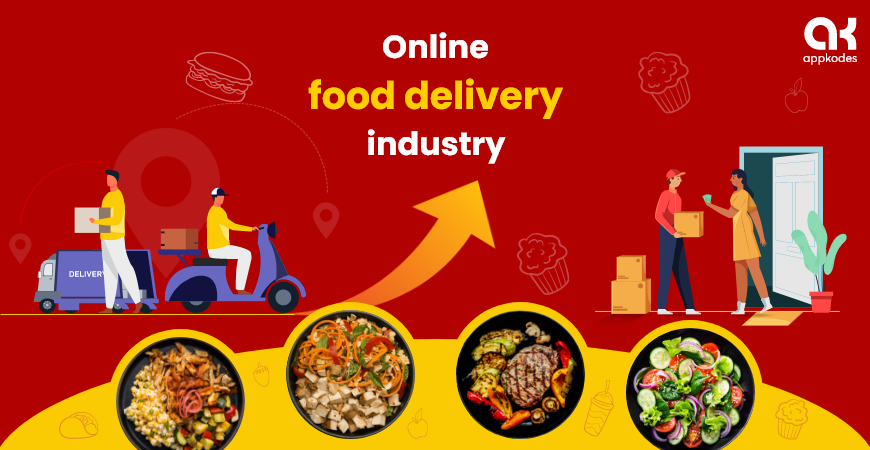“A great idea is just the beginning—execution is everything.” This saying holds true, especially in the competitive world of food delivery apps. If you’ve ever thought about launching a food delivery app, the first question that comes to mind is: Will it be profitable?
The food delivery market is booming, projected to reach $320 billion by 2029. But success isn’t guaranteed. Some apps make millions, while others vanish overnight. The key to success lies in strategic planning, execution, and choosing the right Food Delivery App Development Company. Companies like Appkodes provide scalable and innovative solutions that help businesses thrive in this dynamic industry.
So, how can you determine if your food delivery app idea is profitable? Let’s break it down step by step.
1. Understanding the Market: Is There Demand?
Before diving into development, assess the market demand. Ask yourself:
- Who is your target audience? (Students, working professionals, families, or niche markets?)
- Is there a gap in the market? (Are there unmet needs that your app can solve?)
- Who are your competitors? (UberEats, DoorDash, Zomato, and local players)
Market Research Strategies:
- Analyze industry reports on food delivery trends.
- Conduct surveys to gauge interest.
- Study competitors’ strengths and weaknesses.
Profitability Insight:
If demand is high and existing apps have limitations, your app has potential. If the market is saturated with little differentiation, profitability may be a challenge.
2. Business Model: How Will You Make Money?
A profitable food delivery app must have a sustainable revenue model. Consider these proven strategies:
A. Commission-Based Model
- Charge restaurants a commission per order (typically 15-30%).
- Popular among giants like UberEats and DoorDash.
B. Delivery Fees
- Customers pay a delivery fee (fixed or variable based on distance).
- Some apps charge higher fees during peak hours (surge pricing).
C. Subscription Plans
- Offer premium memberships for free delivery and discounts (e.g., Uber One, Zomato Pro).
D. Advertising & Promotions
- Charge restaurants for sponsored listings.
- Run in-app ads for additional revenue.
Profitability Insight:
Combining multiple revenue streams increases profitability. If your app relies only on commission, high competition may eat into profits.
3. Cost Analysis: Can You Break Even?
Every business has expenses. To determine profitability, calculate startup and operational costs.
Startup Costs:
- App development ($30,000 – $300,000 depending on complexity).
- Legal & licensing fees (permits, business registration, etc.).
- Marketing & branding (launch campaigns, website, ads).
Operational Costs:
- Server & hosting fees (cloud services, data storage).
- Delivery partner wages (fixed salaries or commission-based pay).
- Customer support & maintenance (ongoing improvements, issue resolution).
Break-Even Point Calculation:
- Total Costs (Startup + Operational) / Monthly Revenue = Months to Break Even
- If break-even takes too long (beyond 2-3 years), rethink pricing, operations, or funding strategies.
4. User Experience: Will People Keep Using It?
A profitable app isn’t just about making money—it’s about retaining users. High churn rates kill profitability.
How to Enhance User Experience:
- Seamless UI/UX: Easy ordering, real-time tracking, and simple checkout.
- AI-Powered Recommendations: Personalized menus based on past orders.
- Fast & Reliable Delivery: Partner with quality drivers and optimize routes.
Profitability Insight:
An app that keeps users engaged and ordering frequently is more profitable than one with high downloads but low retention.
5. Marketing Strategy: Can You Attract Customers at Low Cost?
Customer acquisition can be expensive. If marketing costs are too high, profits shrink.
Cost-Effective Marketing Strategies:
- Referral Programs: Encourage users to invite friends.
- Social Media Campaigns: Use viral marketing on TikTok, Instagram, and Twitter.
- Influencer Collaborations: Partner with food bloggers and local influencers.
- SEO & App Store Optimization (ASO): Rank high in search results for organic traffic.
Profitability Insight:
Marketing should drive long-term user engagement, not just downloads. A high customer lifetime value (CLV) ensures profitability.
6. Competitive Edge: What Makes Your App Different?
Unique Selling Points (USPs):
- Hyperlocal Focus: Support small businesses and local cuisines.
- Eco-Friendly Initiatives: Sustainable packaging, carbon-neutral deliveries.
- AI-Driven Smart Orders: Auto-recommendations based on time, preferences, and diet.
- Loyalty Rewards: Cashback, discounts, and gamification.
Profitability Insight:
A strong USP attracts loyal users, reducing marketing costs and increasing repeat orders.
7. Scalability: Can Your App Handle Growth?
Many food apps fail because they can’t scale efficiently. A scalable business model supports expansion without increasing costs exponentially.
Scalability Factors:
- Robust Tech Infrastructure: Cloud-based, flexible architecture.
- Automated Processes: AI-driven logistics and automated customer support.
- Franchise or Partner Model: Expand into new cities with local franchisees.
Profitability Insight:
An app built with scalability in mind will generate higher profits as it grows.
8. Funding & Investment: Can You Secure Capital?
Many startups fail due to lack of funding. Raising capital can help scale faster.
Funding Options:
- Bootstrapping: Self-funding from savings.
- Angel Investors & VCs: Raise capital in exchange for equity.
- Crowdfunding: Get community backing via Kickstarter or Indiegogo.
- Government Grants & Loans: Some regions offer startup incentives.
Profitability Insight:
The right funding source should align with your growth strategy without diluting ownership excessively.
Final Verdict: Is Your Food App Idea Profitable?
Signs of a Profitable App:
- High market demand with an underserved niche.
- Multiple revenue streams for sustainable income.
- Strong retention and repeat customers.
- Efficient marketing with low customer acquisition costs.
- Scalable tech and business model for future growth.
Signs of a Risky Idea:
- Oversaturated market with no differentiation.
- Heavy reliance on promotions leading to low margins.
- High marketing and operational costs without enough revenue.
- No long-term scalability plan.
Conclusion: Cook Up a Profitable Food App!
Launching a successful and profitable food delivery app requires careful planning, market research, and execution. By focusing on demand, revenue models, customer retention, and scalability, you can create an app that not only survives but thrives.
Choosing the right Food Delivery App Development Company like Appkodes ensures that your app is built with industry-best features, security, and scalability in mind. With the right approach, your food delivery app can be the next big success story in the market!








